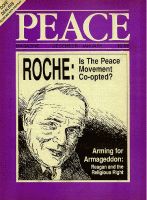
Peace Magazine Dec 1987-Jan 1988, page 29. Some rights reserved.
Search for other articles by Barrie Zwicker here
PETER WATKINS' LATEST FILM, THE JOURNEY, is short -- just 14.5 hours. That's right -- 14.5 hours, but then we must consider Watkins' subject matter -- nothing less than the fate of the earth. The Journey is precisely the length of ABC's mini-series Amerika, the sick, slick anti-Soviet soap which in the end dealt only with the interior of American paranoia.
"Two of our principal concerns in this film are... money and time, and the ways in which we use them on this planet"' Watkins states at the outset: The Journey explores the subjectivity of time by asking us to measure the experience in units of 1,800,000 U.S. dollars, the amount squandered every minute on arms.
Another virtue of The Journey is its planetary perspective. Very early, at about the $10,800,000 mark in the film, we learn that one U.S. nuclear bomb plant is the biggest industrial structure on the face of the planet -- bigger than the Pentagon.
The Journey is a travelogue that will never be produced by the tourism or entertainment industry or by National Geographic. We meet ordinary people in twelve countries on five continents in eight languages discussing their fears, hopes, and the state of their knowledge about fateful issues. They speak in their own languages. (Long stretches of German, Tahitian, Japanese or Russian are untranslated. At these times we are obliged to hear our brothers and sisters through their faces, body language, clothing, surroundings, tones of voice and our own thoughts.)
The Journey is about the failure of the media, in all countries visited except the Soviet Union, to inform the public of the essentials about our planet: As one man says: "I don't think we can say we are informed Rather that we are formed."
The Earth is wired for detonation. But the Earth's technically sophisticated media networks are not being used to inform us of this, let alone warn, urge, instruct, assist or exhort us to save ourselves. They are, in fact, "covering" the biggest story of all time by reporting in the dead hand of the establishments which own them. ([t was Marshall McLuhan who probed the double meaning of "cover" as used in journalism.)
As a teenage German girl says: "The media neglect [important issues], yet defend themselves by saying: 'Look, we showed you a little.' Self-initiative is the only way now. Problems can't be solved in the ways the media have instructed so far." Self-initiative such as this magazine. If there's a single message in The Journey it is that we must support and build alternative media, alternative educational curricula and structures, alternative ways of seeing, even while using, and working to modify, the existing media and educational structures.
Some of those we meet in The Journey have developed a particular wisdom as a result of their reflections on the information they have been denied. At about $l,44,000,000 a Tahitian woman says: "TV and newspapers say Soviets want war. These Russians say no. [The people in the film were shown clips of others' views in The Journey.]Who speaks the truth, this family or the newspaper?"
"The fact we don't know about the daily life of Russians shows something is not right"' says a Japanese father. "Some interference is blocking our understanding."
The Journey opens rather thin blocks. This does not make it an easy film, but it is educative. It is uncompromising. It is democratic in impulse and production. It is flawed. Some of what ordinary people say is dumb, but never as dumb as what Reagan and Mulroney say in the film. The Journey is intended to stimulate debate. It is historic, heroic and imperfect: Sister Mary Jo Leddy once wrote: "It is time for ordinary people to do extraordinary things." Those who produced The Journey did.
Barrie Zwicker is a Toronto media critic, activist and publisher.

Peace Magazine Dec 1987-Jan 1988, page 29. Some rights reserved.
Search for other articles by Barrie Zwicker here